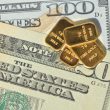Gold prices trade near one-week lows as bullion fails to capitalize on U.S. recession worries fueled by mixed economic data. Strong manufacturing indicators are driving yields and the dollar higher to the detriment of zero-yielding gold to start in 2024.
XAU/USD Prices briefly pierced below $2,000 support midweek before stabilizing around $2,016 at press time. Still, persistent dollar strength tied to expectations for steady rate hikes from the Federal Reserve continues to weigh on the precious metal.
Most analysts foresee limited upside prospects for gold prices in the coming sessions, even as growth risks linger on the horizon. The recent rise in Treasury yields makes holding non-interest-bearing assets like bullion more unfavorable in that scenario.
Over the near term, traders are watching whether still-resilient data will force markets to rethink the notion of the Fed easing later this year. Comments from policymakers suggest rates could stay higher for longer if strong economic momentum holds up.
Also read: Tesla Bitcoin Holdings Remain Unchanged Despite Market Turbulence
Such rhetoric tends to boost the dollar—a negative for gold priced internationally. It also drives speculation that recession probabilities are overblown despite ongoing inflation squeezes and supply chain issues.
Gold prices are likely to experience volatility
Those conflicting forces leave gold price consolidating, with more volatility likely on tap. From a technical perspective, repeated failures to climb above $2,025 resistance on the charts signal reluctance by dip buyers to push higher as well.


Until yields show sustained declines or the dollar’s uptrend convincingly reverses, analysts suspect topside moves will remain sold into. That leaves rangebound chop between around $1,960 and $2,050 in play, absent surprise catalysts in either direction.
With high-impact events like U.S. GDP data and an ECB policy decision ahead, the opportunity exists for unforeseen drivers to jolt gold from its narrow equilibrium. But for now, resilient data and Fed rhetoric seem poised to limit buying appetite in the near term.





